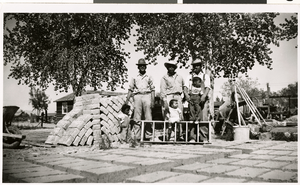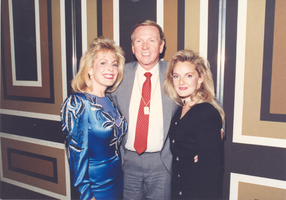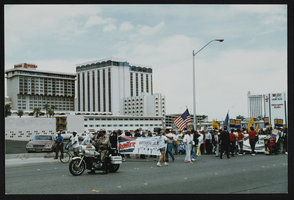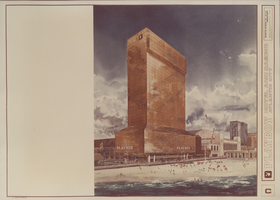Search the Special Collections and Archives Portal
Search Results

Architectural drawing of the New Frontier Hotel and Casino (Las Vegas), reconstruction and addtions, preliminary rough perspective, October 17, 1960
Date
Archival Collection
Description
Preliminary rough perspective, proposed reconstruction and additions of the New Frontier Hotel and Casino, Las Vegas.
Site Name: Frontier
Address: 3120 Las Vegas Boulevard South
Image

Photograph of Fransisco Rivero and helpers at the Hazzle Street adobe company, North Las Vegas (Nev.), 1948
Date
Archival Collection
Description
Image

Photograph of Heidi Sarno with unidentified people, 1980s
Date
Archival Collection
Description
Image

Two signs in the desert: photographic slide
Date
Archival Collection
Description
From the Sister Klaryta Antoszewska Photograph Collection (PH-00352). Sign on the left reads: "NOTICE vehicles transporting explosives STOP 1000 ft. ahead use telephone for instructions". Sign on the right reads: "Unauthorized explosives prohibited on the Nevada Test Site".
Image

Photographs of Frontier Strike: Jesse Jackson, Culinary Union, Las Vegas (Nev.), 1992 April 21 (folder 1 of 13)
Date
Archival Collection
Description
Frontier Strike participants march near the Hilton Hotel and Casino and the Las Vegas Convention Center. Strikers are holding banners, signs, and multiple flags, including the American flag. Banners reading "Conquering the Frontier, Culinary Local 226, Bartenders Local 165" and "Service Employees International Union, AFL-CIO, CLC" are prominently displayed. On site are former secretary-treasurer of the Culinary Workers Union, Jim Arnold, and American civil rights activist, Jesse Jackson. Arrangement note: Series I. Demonstrations, Subseries I.A. Frontier Strike. Site name: The Strip (Las Vegas, Nev.)
Image

Photographs of Frontier Strike: Jesse Jackson, Culinary Union, Las Vegas (Nev.), 1992 April 21 (folder 2 of 13)
Date
Archival Collection
Description
Frontier Strike participants march on the Las Vegas Strip near the Riviera, Hilton, Stardust, and Frontier. Strikers are holding banners, protest signs, and multiple flags, including the American flag. Banners reading "Conquering the Frontier, Culinary Local 226, Bartenders Local 165" and "Service Employees International Union, AFL-CIO, CLC" are prominently displayed. On site is former secretary-treasurer of the Culinary Workers Union, Jim Arnold, and American civil rights activist, Jesse Jackson. Arrangement note: Series I. Demonstrations, Subseries I.A. Frontier Strike. Site name: The Strip (Las Vegas, Nev.)
Image

Proposal for the Playboy Hotel and Casino, Atlantic City, 1977
Date
Archival Collection
Description
Bound proposal for Playboy Hotel and Casino including artist's conceptions, vicinity map, themes, and architectural drawings for all major components. Includes note on protective cover: "First concept, Constructed as modified."
Site Name: Playboy Hotel and Casino (Atlantic City)
Address: Florida Ave & Boardwalk, Atlantic City, NJ
Image
UNLV Black Lives Matter Web Archive
Identifier
Abstract
The UNLV Black Lives Matter Web Archive (2020) is comprised of two statements and one op-ed which were published shortly after the murders of George Floyd and Ahmaud Arbery and the subsequent rise of the Black Lives Matter movement. The statements come from Thom Reilley, Chancellor of Nevada System of Higher Education (NSHE), and Marta Meana, Interim President of the University of Nevada, Las Vegas (UNLV). Both statements express NSHE and UNLV's message of solidarity with the Black community and affirm the University's commitment to diversity, equity, and inclusion. The op-ed was written by UNLV alumna Jessica Walters Murrey who is a "social change and communication expert." The op-ed acknowledges Murrey's pain and grief and also outlines actionable steps that non-Black individuals can take to support the Black community.
Archival Collection
Janet Adams oral history interview
Identifier
Abstract
Oral history interview with Janet Adams conducted by Glodene Sawyer on October 13, 1972 for the Ralph Roske Oral History Project on Early Las Vegas. Adams (born in Scotland) discusses her move to Las Vegas, Nevada from California with her husband. Adams also briefly discusses early churches, the above-ground atomic testing, President Kennedy’s visit, and her enjoyment in recreational fishing.
Archival Collection

Second generation concrete base design for heliostats, Crescent Dunes Solar, near Tonopah, Nevada: digital photograph
Date
Archival Collection
Description
Photographer's assigned keywords: "110 megawatts; CSP; Concentrated Solar Energy; Concentrated Solar Power; Crescent Dunes; NV; Nevada; Solar Reserve; SolarReserve; Tonopah; concentrated solar thermal; green energy; ground-based photo; molten salt; on-site; renewable energy; storage; tower."
Image
